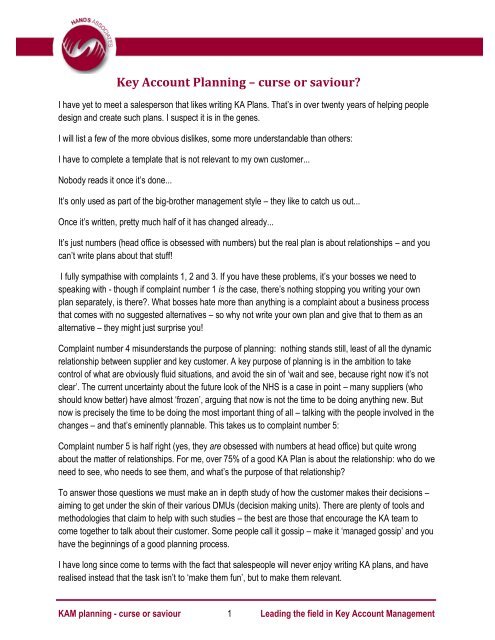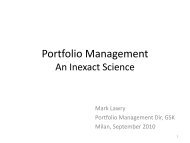Key Account Planning -curse or saviour.pdf - Pharma
Key Account Planning -curse or saviour.pdf - Pharma
Key Account Planning -curse or saviour.pdf - Pharma
- No tags were found...
Create successful ePaper yourself
Turn your PDF publications into a flip-book with our unique Google optimized e-Paper software.
<strong>Key</strong> <strong>Account</strong> <strong>Planning</strong> – <strong>curse</strong> <strong>or</strong> <strong>saviour</strong>?I have yet to meet a salesperson that likes writing KA Plans. That’s in over twenty years of helping peopledesign and create such plans. I suspect it is in the genes.I will list a few of the m<strong>or</strong>e obvious dislikes, some m<strong>or</strong>e understandable than others:I have to complete a template that is not relevant to my own customer...Nobody reads it once it’s done...It’s only used as part of the big-brother management style – they like to catch us out...Once it’s written, pretty much half of it has changed already...It’s just numbers (head office is obsessed with numbers) but the real plan is about relationships – and youcan’t write plans about that stuff!I fully sympathise with complaints 1, 2 and 3. If you have these problems, it’s your bosses we need tospeaking with - though if complaint number 1 is the case, there’s nothing stopping you writing your ownplan separately, is there?. What bosses hate m<strong>or</strong>e than anything is a complaint about a business processthat comes with no suggested alternatives – so why not write your own plan and give that to them as analternative – they might just surprise you!Complaint number 4 misunderstands the purpose of planning: nothing stands still, least of all the dynamicrelationship between supplier and key customer. A key purpose of planning is in the ambition to takecontrol of what are obviously fluid situations, and avoid the sin of ‘wait and see, because right now it’s notclear’. The current uncertainty about the future look of the NHS is a case in point – many suppliers (whoshould know better) have almost ‘frozen’, arguing that now is not the time to be doing anything new. Butnow is precisely the time to be doing the most imp<strong>or</strong>tant thing of all – talking with the people involved in thechanges – and that’s eminently plannable. This takes us to complaint number 5:Complaint number 5 is half right (yes, they are obsessed with numbers at head office) but quite wrongabout the matter of relationships. F<strong>or</strong> me, over 75% of a good KA Plan is about the relationship: who do weneed to see, who needs to see them, and what’s the purpose of that relationship?To answer those questions we must make an in depth study of how the customer makes their decisions –aiming to get under the skin of their various DMUs (decision making units). There are plenty of tools andmethodologies that claim to help with such studies – the best are those that encourage the KA team tocome together to talk about their customer. Some people call it gossip – make it ‘managed gossip’ and youhave the beginnings of a good planning process.I have long since come to terms with the fact that salespeople will never enjoy writing KA plans, and haverealised instead that the task isn’t to ‘make them fun’, but to make them relevant.KAM planning - <strong>curse</strong> <strong>or</strong> <strong>saviour</strong> 1 Leading the field in <strong>Key</strong> <strong>Account</strong> Management
If salespeople can see a genuine return from the eff<strong>or</strong>t of planning, they’ll get on with it.Plans full of numbers don’t promise much in the way of return, Now, numbers are part of it, and manywould say they’re the whole point of it. They may be the final objective, but they are not the whole point. Aplan is about how to achieve something, not a bald statement of the final goal. And when it comes to thehow, it comes to the people. We are back to the following simple questions:How does the customer make their decision?Who is involved in that decision and in relationship with whom?What ‘turns them on?’, and just as imp<strong>or</strong>tantly, ‘what turns them off?’.How can we help them make their decision faster, and, of course, in our favour?Who from our side needs to be involved – who sees whom, and why?Nobody is saying that it’s easy answering these questions, the hardest task being getting to grips with whathappens inside the customer, often behind closed do<strong>or</strong>s, and not always with the greatest of efficiency!Here is another reason f<strong>or</strong> planning, and perhaps the most imp<strong>or</strong>tant of the lot: if your planning processresults in a m<strong>or</strong>e efficient customer, then its a good planning process.Which brings us to a final thought: might you be able to share your KA plan with the customer? It’s a greatambition, and a mark of a true partner, and of a key supplier, but if you do head in that direction be evenm<strong>or</strong>e certain that your own planning process is relevant – don’t expect the customer to appreciate‘templates’ and ‘bald numbers’ any m<strong>or</strong>e than you do!The secret is to be found in a planning process that involves them – and a good start is to find a way toinvolve your own people in that planning process. Why not start by talking about the people in thecustomer...Peter ChevertonINSIGHT Marketing And People LtdPeter.cheverton@insight-mp.comF<strong>or</strong> m<strong>or</strong>e info contact Hands Associates LTDE : enquiries@handsassociates.comT : 0161 246 6017W : www.handsassociates.comKAM planning - <strong>curse</strong> <strong>or</strong> <strong>saviour</strong> 2 Leading the field in <strong>Key</strong> <strong>Account</strong> Management





